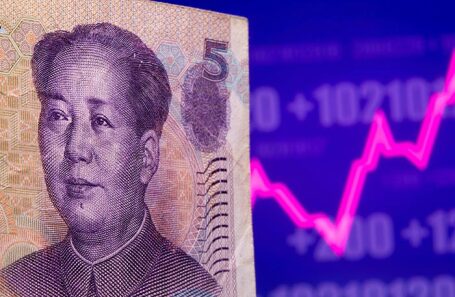Plant both in the same fieldsThat is what the US does. Crop rotation of corn and soybeans.
You are using an out of date browser. It may not display this or other websites correctly.
You should upgrade or use an alternative browser.
You should upgrade or use an alternative browser.
Chinese Economics Thread
- Thread starter Norfolk
- Start date
Moscow Exchange to launch trading in yuan futures with new parameters
From April 21, a settlement futures contract for the yuan-ruble currency pair will be available for participants in the derivatives market of the Moscow Exchange and their clients, aimed at private investors

The Moscow Exchange on Thursday, April 21, an updated futures contract for the yuan-ruble pair. The main change is the denomination of the contract reduced by ten times to 1,000 yuan. The trading platform explained its decision by the growing popularity of the yuan among Russian investors. In March, the volume of Chinese currency trading on the Moscow Exchange increased eight times compared to the previous month.
The exchange first trading yuan futures seven years ago. With a reduction in the minimum contract price, this instrument will become available, including to retail investors, Pavel Pakhomov, head of the analytical center of the St. Petersburg Exchange, notes:
- Lots, especially where the underlying asset is foreign assets - gold, silver, oil, and so on - are specially reduced so that small investors with amounts within 10 thousand rubles can trade. Therefore, this is a normal story in order to terminate contracts in order to attract a larger number of participants who will work with a very small amount and thereby increase liquidity.
Who might be interested in this tool?
— This is a speculative instrument. In principle, we have a speculative market, especially if we talk about the futures market. Therefore, there are speculators here, and small speculators at that.
The Moscow Exchange reports a significant increase in trading volume in March not only for the Chinese yuan, but also for the Turkish lira and the Belarusian ruble.
This is basically important as a way for Russian companies which do trade with China to be able to hedge their currency conversions.
It might also be used for useless speculation but that is just what happens with markets.
From the article it also seems like Russian businesses expect increased trade with Belarus and Turkey.
Russia already loosened some of their trade restrictions with regards to Turkish agricultural imports. They also seem to be discussing relaxing transport and tourism to Turkey.
It might also be used for useless speculation but that is just what happens with markets.
From the article it also seems like Russian businesses expect increased trade with Belarus and Turkey.
Russia already loosened some of their trade restrictions with regards to Turkish agricultural imports. They also seem to be discussing relaxing transport and tourism to Turkey.
Rmb is weakening for another day, the beginning of depreciation by PBOC and fed hikes, or short term covid results ?
Another good reform
Chinese employees will henceforth be able to invest and supplement funds in their pension accounts, authorities said on Thursday, launching the country's first private pension scheme as they tackle economic challenges linked to an ageing population.
Employees can contribute up to 12,000 yuan ($1,860) per year to their pension fund under the new scheme, which will be rolled out with one-year trials in some cities before being implemented nationwide, the government said in a policy document on its website.
Until now, both employees and employers have contributed fixed amounts under state pension plans.
The milestone marks the official launch of China's private pension sector after almost four years of pilots, and is expected to spur foreign insurers and asset managers to accelerate their expansion into the world's most populous nation.
"In the mid to long term, the new policy will benefit the retirement market by helping to accumulate more retirement income, increasing residents' retirement savings as well as investing awareness," said Leo Shen, Shanghai-based China head of fund management business at Allianz Global Investors.
To encourage participation, the contributions - whose maximum value the government will adjust as economic conditions dictate - will be eligible for tax breaks, while the securities regulator said it would quickly formulate rules to facilitate pension investment by mutual funds.
By FAN FEIFEI in Beijing and YANG JUN in Guiyang | China Daily | Updated: 2022-04-21 09:17

A time tunnel effect is displayed at Guizhou province's big data demonstration center in Guiyang. [Photo/Xinhua]
Transformation efforts bear fruit as region sees surge in industrial output
The industrial economy in China's western regions has registered speedy growth in the first quarter, with high-tech and emerging industries injecting fresh impetus into regional economic development amid uncertainties both at home and abroad, industry experts said.
The industrial output of Southwest China's Guizhou province increased 15.2 percent year-on-year in the first three months-8.7 percentage points higher than that of the nation, said the provincial bureau of statistics.
High-tech and emerging industries have seen remarkable growth, as output from new energy vehicle batteries and materials industry surged 44.9 percent year-on-year in the first quarter, 29.7 percentage points higher than that of overall industrial output in the province.
Meanwhile, output from the computing, telecommunications and other electronics equipment manufacturing sector in Guizhou surged 35.4 percent on a yearly basis.
During the January-March period, investment in high-tech industries surged 96.1 percent compared with the same period of the previous year. Among the total, investment in high-tech manufacturing and high-tech services industries increased 129.6 percent and 66.8 percent year-on-year, respectively.
In addition, industrial output in Sichuan province grew 8.1 percent year-on-year in the first quarter, with the output from electrical machinery and equipment manufacturing rising 39.3 percent year-on-year, according to local authorities.
"The western regions have ratcheted up efforts to build a modern industrial system and develop big data and cloud computing technologies, showcasing strong resilience and great potential in bolstering the development of high-tech and emerging industries," said Luo Zhongwei, a researcher at the Institute of Industrial Economics, which is part of the Chinese Academy of Social Sciences.
The government's decision to establish eight national computing hubs and 10 national data center clusters demonstrates that the country is taking steps to channel more computing resources from its eastern regions to less-developed but resource-rich western regions and the move will speed up digital transformation and upgrade industries in western regions, Luo added.
In January, China issued a guideline to support Guizhou in breaking new ground in the country's pursuit of fast development of its western regions in the new era. The guideline, released by the State Council, China's Cabinet, underscored the importance of promoting the construction of an inland open-economy pilot zone and developing the digital economy.
Guizhou has seen rapid development in its big data industry in recent years, with tech giants from home and abroad stepping up efforts to set up data centers in the province due to its cooler climate and ample power resources.
Chongqing has also witnessed its industrial output rise 8.5 percent on a yearly basis in the first three months. The output of emerging industries, such as photovoltaic cells, industrial robots and service robots, expanded 92.9 percent, 34.1 percent and 20.7 percent, respectively, higher than the overall first-quarter industrial output.
The western regions have abundant renewable energy and will become a key base for developing strategic emerging industries in the nation, said Xiang Ligang, director-general of the Information Consumption Alliance, a telecom industry association, adding that compared with the Yangtze River Delta and the Pearl River Delta areas, manpower costs are relatively low in western regions.
Xiang added that more efforts should be made to speed up some key industries including equipment manufacturing, new materials and new energy vehicles in western regions to promote the nation's high-quality economic development.
China's industrial economy maintained steady growth in the first quarter, with industrial output growing 6.5 percent year-on-year, 2.6 percentage points higher than that of the fourth quarter of last year, said the National Bureau of Statistics.
Overestimating US growth projection as well. This year is going to be disruptive like the beginning of Covid pandemic, making estimates right now is unreliable. They will most likely revise that number after every quarter or so.IMF decreased China's growth projection to 4.4%, only 0.7% higher than US at 3.7%
Thoughts? I think they're underestimating China given they have a history of doing that. They missed the mark by 2 trillion in 2021 iinm
They are underestimating.IMF decreased China's growth projection to 4.4%, only 0.7% higher than US at 3.7%
Thoughts? I think they're underestimating China given they have a history of doing that. They missed the mark by 2 trillion in 2021
However.. if China has a another covid lockdown mess Shanghai-style, then 4.4% would be about right.
So the question should be:
Do you think that China will have more such Covid lockdowns from now till the end of the year?
Shanghai is the last such lockdown China will impose, ever.They are underestimating.
However.. if China has a another covid lockdown mess Shanghai-style, then 4.4% would be about right.
So the question should be:
Do you think that China will have more such Covid lockdowns from now till the end of the year?
